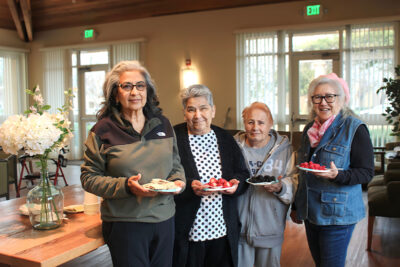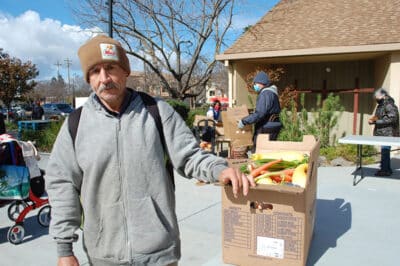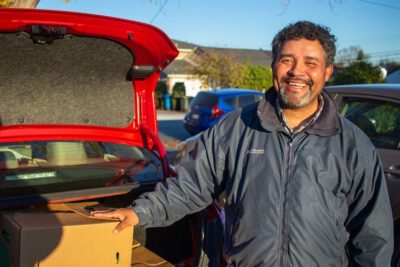Nourishment is fundamental to good health not just in the short term; it contributes to better mental and physical health in the long run as well. Food insecurity has a negative effect on physical, mental and emotional health and is associated with increased risk for chronic health conditions like diabetes, obesity, heart disease, mental health disorders and other diseases.
Knowing that food is medicine, in 2009, Second Harvest of Silicon Valley began developing partnerships with medical providers to address the vital link between nutrition and health. Kelly Chew, Second Harvest’s director of services says, “We recognized that food insecurity often goes hand in hand with poor health outcomes. This holistic approach allows us to tackle both hunger and health issues more effectively, ultimately creating a stronger, healthier community.”
Second Harvest has developed partnerships with 61 medical partners with more than 400 medical providers across Santa Clara and San Mateo counties. We help partners incorporate food insecurity screening into standard patient intake procedures and connect individuals to resources when they screen positive. This is filling an important need for healthcare providers.
“As we started gathering data about the needs of our patients, food and connections to food was one of the things that most commonly showed up,” explained Mariana Becerra, enhanced care management/community supports program supervisor at Gardner Health Services, which provides comprehensive medical and mental healthcare to patients in Santa Clara and San Mateo counties. “We started looking into ways to connect our patients to food and began working with Second Harvest. It’s been really helpful.”
Expanding access to nutritious food
These food bank and healthcare partnerships reduce barriers for patients to access food assistance and also:
- • enable more patients to be connected to short- and long-term nutrition assistance programs like CalFresh and other programs;
- • increase provider capacity to work food insecurity relief strategies into patient treatment plans; and
- • ultimately, help prevent the onset of diet-related health conditions.
“One of the most important things we focus on in our program is to help patients that have chronic conditions like diabetes and making sure we’re able to help them lower their A1C,” said Becerra. “We can provide so much health education but if there’s no access to healthy food, then there’s only so much we can do. That’s why I feel like food is the biggest part of getting somebody healthy.”
Accelerating patient access to nutritious food
We utilize a four-step process to screen, refer, and quickly connect patients at risk for food insecurity with nutritious food and other resources when appropriate:
Empowering our community through expanded medical partnerships
In fiscal year 2021, we worked with 27 medical partners across Santa Clara and San Mateo counties. By fiscal year 2023, that number had more than doubled to 61, including:
- • Kaiser Permanente
- • Santa Clara Valley Medical Center – Hospital and Clinics
- • San Mateo Medical Center
- • Stanford Health Care
- • Stanford Medicine Children’s Health
“This [access to food] is so critical,” shared a provider. “I often hear myself telling patients, ‘Take this with the largest meal of the day,’ and meanwhile they are thinking about their lack of food. It makes all the difference.”
“Thank you so much for asking me,” said a patient. “I didn’t know how or think to tell you I didn’t have enough. I am so grateful.”
Helping thousands of local patients
Second Harvest’s medical partnerships have identified and helped thousands of patients who may be food insecure. In fiscal year 2021, providers referred 765 patients to Second Harvest, and, by fiscal year 2023, that number had grown to 2,174 patients.
“I was at first very uncomfortable but then the doctor explained why it is important to get healthy food for medical reasons and they really made sense to me,” said another patient. “I was not uncomfortable anymore.”
A provider shared that, “someone screened positive for depression but when I talked to them, they were just hungry. If I wouldn’t have learned to ask about food, I would have just sent them to the therapist.”
Expanding reach to serve more neighbors needing food assistance
The vast majority of patients served through this program were households with children or seniors, enabling us to reach some of the area’s most vulnerable populations by partnering with medical providers.
| FY2023 | Total Households Assisted with Food Referral |
|---|---|
| Households with seniors | 473 (27%) |
| Households with children (18 under) | 757 (43%) |
| Average household size | 2.8 |
“It’s been a really useful tool to have, that easy connection into Second Harvest,” said Becerra. “To be able to submit the referrals and then help the patients. It’s been very helpful.”
“Our medical partnership program is enhancing community health by fostering collaboration between healthcare providers and community members.” said Chew. “Access to healthy food is a key part of our strategy, helping to prevent and manage chronic diseases. By improving access to nutritious food, we’re building a healthier, more resilient community.”





